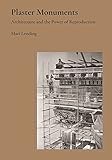Plaster Monuments : Architecture and the Power of Reproduction / Mari Lending.
Material type: TextPublisher: Princeton, NJ : Princeton University Press, [2022]Copyright date: ©2018Description: 1 online resource (304 p.) : 48 color + 73 b/w illusContent type:
TextPublisher: Princeton, NJ : Princeton University Press, [2022]Copyright date: ©2018Description: 1 online resource (304 p.) : 48 color + 73 b/w illusContent type: - 9780691239620
- ARCHITECTURE / Historic Preservation / General
- Aestheticism
- Alabaster
- Alexander Liberman
- Ancient art
- Ancient monument
- Archaeology
- Architecture
- Art history
- Artificial ruins
- Ashurnasirpal II
- Assyrian sculpture
- Baptistery
- Barry Bergdoll
- Beaux-Arts architecture
- Belvedere Torso
- Black Mountain College
- Brutalist architecture
- Carnegie Museum of Art
- Cast Courts (Victoria and Albert Museum)
- Charles Barry
- Charles Jencks
- Choragic Monument of Lysicrates
- Curator
- Descriptive Catalogue (1809)
- Eduard Schaubert
- Egyptian Museum
- Engraving
- Entablature
- Erechtheion
- Ernst Curtius
- Facsimile
- Factum Arte
- Fine art
- French architecture
- Glittering Images
- Glyptothek
- Gothic architecture
- Gottfried Semper
- Harvard University
- High Renaissance
- Illustration
- In Search of Lost Time
- In situ
- James Fergusson (architect)
- Johann Joachim Winckelmann
- John Ruskin
- John Soane
- Josef Albers
- Knoedler
- Lachish relief
- Le Corbusier
- Lewis Nockalls Cottingham
- Lincoln's Inn Fields
- Louis Comfort Tiffany
- Luca della Robbia
- Marcel Breuer
- Matthew Digby Wyatt
- Mausoleum at Halicarnassus
- Medievalism
- Metope
- Metropolitan Museum of Art
- Modern architecture
- Modernism
- Moulage
- Museum
- Nimrud
- Parthenon Frieze
- Patina
- Paul Rudolph (architect)
- Pediment
- Phidias
- Philip Johnson
- Photography
- Picturesque
- Plaster cast
- Plaster
- Rachel Whiteread
- Renaissance Revival architecture
- Richard Howland Hunt
- Romanesque architecture
- Romanticism
- Sanchi
- Scale model
- Sculpture
- Sir John Soane's Museum
- Slater Memorial Museum
- Stairs
- Stave church
- Temple of Castor and Pollux
- Temple of Dendur
- Trajan's Column
- Tutankhamun
- Venus de Milo
- Victoria and Albert Museum
- Vincent Scully
- Walter Benjamin
- Well of Moses
- Winged Victory of Samothrace
- Work of art
- Yale University Library
- 702.8/72 23
- online - DeGruyter
| Item type | Current library | Call number | URL | Status | Notes | Barcode | |
|---|---|---|---|---|---|---|---|
 eBook
eBook
|
Biblioteca "Angelicum" Pont. Univ. S.Tommaso d'Aquino Nuvola online | online - DeGruyter (Browse shelf(Opens below)) | Online access | Not for loan (Accesso limitato) | Accesso per gli utenti autorizzati / Access for authorized users | (dgr)9780691239620 |
Browsing Biblioteca "Angelicum" Pont. Univ. S.Tommaso d'Aquino shelves, Shelving location: Nuvola online Close shelf browser (Hides shelf browser)
Frontmatter -- Contents -- Acknowledgments -- Introduction: Monuments in Flux -- Chapter 1 Travels in the Province of Reproductions -- Chapter 2 Trocadéro: Proust’s Museum -- Chapter 3 The Poetics of Plaster -- Chapter 4 Cablegrams and Monuments -- Chapter 5 The Yale Battle of the Casts: Albers vs. Rudolph -- Coda Lost Continents, Fluctuating Objects -- Notes -- Bibliography -- Index -- Illustration Credits
restricted access online access with authorization star
http://purl.org/coar/access_right/c_16ec
We are taught to believe in originals. In art and architecture in particular, original objects vouch for authenticity, value, and truth, and require our protection and preservation. The nineteenth century, however, saw this issue differently. In a culture of reproduction, plaster casts of building fragments and architectural features were sold throughout Europe and America and proudly displayed in leading museums. The first comprehensive history of these full-scale replicas, Plaster Monuments examines how they were produced, marketed, sold, and displayed, and how their significance can be understood today.Plaster Monuments unsettles conventional thinking about copies and originals. As Mari Lending shows, the casts were used to restore wholeness to buildings that in reality lay in ruin, or to isolate specific features of monuments to illustrate what was typical of a particular building, style, or era. Arranged in galleries and published in exhibition catalogues, these often enormous objects were staged to suggest the sweep of history, synthesizing structures from vastly different regions and time periods into coherent narratives. While architectural plaster casts fell out of fashion after World War I, Lending brings the story into the twentieth century, showing how Paul Rudolph incorporated historical casts into the design for the Yale Art and Architecture building, completed in 1963.Drawing from a broad archive of models, exhibitions, catalogues, and writings from architects, explorers, archaeologists, curators, novelists, and artists, Plaster Monuments tells the fascinating story of a premodernist aesthetic and presents a new way of thinking about history’s artifacts.
Mode of access: Internet via World Wide Web.
In English.
Description based on online resource; title from PDF title page (publisher's Web site, viewed 29. Mai 2023)









